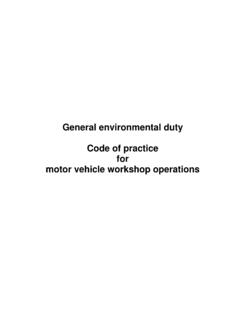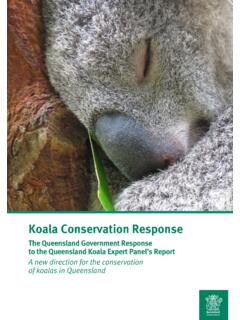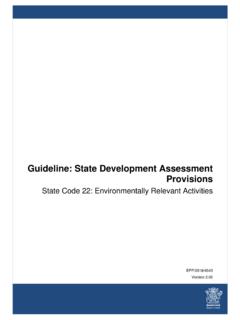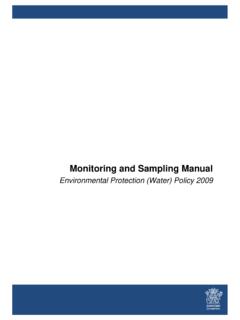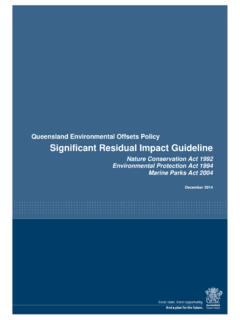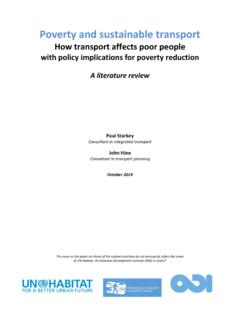Transcription of Koala-sensitive Design Guideline
1 Koala-sensitive Design Guideline A guide to Koala-sensitive Design measures for planning and development activities EPP/2019/5154. Prepared by: Environmental Planning and Policy, Department of Environment and Science State of Queensland, 2019. The Queensland Government supports and encourages the dissemination and exchange of its information. The copyright in this publication is licensed under a Creative Commons Attribution Australia (CC BY) licence. Under this licence you are free, without having to seek our permission, to use this publication in accordance with the licence terms. You must keep intact the copyright notice and attribute the State of Queensland as the source of the publication. For more information on this licence, visit Version Effective date Description of changes 1/11/2012. Update to reflect policy and legislation changes.
2 Updated Government 01/02/2020. template and style. Disclaimer The department holds no responsibility for any errors or omissions within this document. Any decisions made by other parties based on this document are solely the responsibility of those parties. Information contained in this document is from a number of sources and, as such, does not necessarily represent government or departmental policy. If you need to access this document in a language other than English, please call the Translating and Interpreting Service (TIS. National) on 131 450 and ask them to telephone Library Services on +61 7 3170 5470. This publication can be made available in an alternative format ( large print or audiotape) on request for people with vision impairment; phone +61 7 3170 5470 or email January 2020. Page ii of 20 EPP/2019/5154 Version Effective: 01 FEB 2020 Review: 01 FEB 2020 Department of Environment and Science Contents Overview.
3 1. 1. Explanatory statement ..1. Purpose of Guideline ..1. Koala-sensitive Design principles ..1. Use of Guideline ..1. 2. Development planning, Design and layout principles ..1. Threats to koalas ..1. Habitat connectivity value for koala movement ..1. Planning, Design and layout principles for koala conservation ..3. 3. Design guide for koala safety and movement ..5. koala -friendly fencing ..5. koala -safe road Design and placement ..5. koala -safe pools ..6. Mitigation of threats from domestic Community awareness ..6. 4. How to implement koala -safe movement solutions ..6. Table 1: Guide to koala Sensitive Design - koala friendly Table 2: Guide to koala Sensitive Design - koala safe transport infrastructure Design and placement ..11. Table 3: Guide to koala Sensitive Design - koala safe pools ..14.
4 Table 4: Guide to koala Sensitive Design - koala safe from dogs ..15. Table 5: Guide to koala Sensitive Design - community awareness ..16. Definitions ..17. Page iii of 20 EPP/2019/5154 Version Effective: 01 FEB 2020 Review: 01 FEB 2020 Department of Environment and Science Overview 1. Explanatory statement Purpose of Guideline The Koala-sensitive Design Guideline provides advice and information for managers, land-use planners, infrastructure providers and development applicants to determine appropriate measures to help avoid and minimise the impact of development and land-use planning on koala populations. It can be used by government and non- government organisation, developers, private consultants and community members. The Guideline also provides information on what is needed to meet the requirements of the State code 25: Development in South East Queensland koala habitat areas ( koala SDAP) and State Planning Policy (Biodiversity).
5 (SPP) in relation to: ensuring that koala safety and movement are maximised through Design and layout of development ensuring koala safety and movement are maximised through Design and layout of development managing risks to koalas on-site during construction phases. Koala-sensitive Design principles Measures in this Guideline are based on koala sensitive Design principles that help development: retain and protect koala habitat values in their natural state to allow koalas to feed, rest and move around achieve permeability for koalas through the landscape to ensure the safe movement of koalas within and across a site reduce threats to resident and transient koalas. Use of Guideline This Guideline can be used to: identify threats that development activities have on safe koala movement identify appropriate Koala-sensitive Design measures to avoid and minimise those threats provide principles and techniques to inform the planning, Design and layout stages of development for retaining koala populations and providing for koala safety and movement apply the SPP and koala SDAP outcomes for assisting the retention of viable koala populations and providing koala safe movement opportunities.
6 2. Development planning, Design and layout principles Threats to koalas The movement of individual koalas to different populations and territories allows important genetic exchange which is essential for koala population viability. High rates of development in South East Queensland (SEQ) are removing and fragmenting koala habitat and increasingly threatening the safe movement of koalas across the landscape. koala mortality can be a direct result of human-induced threats from urbanisation and development. Specific threats to koalas from urban development activities include: loss of habitat habitat fragmentation vehicle strike ( koala injury or death). domestic dog attacks ( koala injury or death). increased prevalence of disease (increased susceptibility to disease due to stress caused by the above-mentioned threats).
7 Habitat connectivity value for koala movement koala habitat connectivity value for koala movement should be determined and used in development planning, Design and layout. To determine the habitat connectivity values of the site, with regards to facilitating koala movement through the Page 1 of 20 EPP/2019/5154 Version Effective: 01 FEB 2020 Review: 01 FEB 2020 Department of Environment and Science landscape, the following factors should be taken into consideration: 1. The site's location with regards to the following: areas identified as koala habitat area areas that are other remnant or regulated regrowth regional ecosystems where koalas are known to occur areas of environmental significance waterway and ecological corridors. 2. The attributes of the site, including the following: presence of koalas condition of the habitat the presence of any of the following on the site: o waterway and ecological corridors o areas that are remnant or regulated regrowth regional ecosystems where koalas are known to occur.
8 3. Any factors which diminish the site's habitat connectivity value for koala movement, including: edge effects and other indirect impacts of development on ecological features the presence of infrastructure and services, such as roads, which present barriers for koala movement and dispersal. In summary, the site's location and attributes with regards to the presence of koalas, location and condition of habitat, waterways and ecological corridors and any factors impacting on these values should be taken into consideration for planning and development. An assessment for koala habitat connectivity value should include: the use or potential use of the site and areas adjacent to the site by koalas a plan of koala habitat (including bushland, groups of trees or individual trees). a plan of movement corridors (connectivity) including regional and local-scale movement corridors and existing and potential links between koala habitat within and external to the site.
9 Figures 1 to 4 below provide examples of considerations for assessing koala habitat and habitat connectivity value for a given parcel of land and of koala habitat features to incorporate into development Design . Figure 1. Example of determining koala habitat and connectivity value for koala movement Page 2 of 20 EPP/2019/5154 Version Effective: 01 FEB 2020 Review: 01 FEB 2020 Department of Environment and Science Planning, Design and layout principles for koala conservation Following an assessment of koala habitat and habitat connectivity values, the planning, Design and layout of the development should incorporate the following principles: Ensure areas of koala habitat values and habitat connectivity are protected and enhanced by: o retaining, enhancing or creating large contiguous patches of koala habitat o avoiding clearing non-juvenile koala habitat trees on the site, including individual, isolated trees o linking on-site koala habitat to koala habitat located external to the site o identifying rehabilitation areas on site and revegetating consistent with densities, composition and distribution of native koala habitat vegetation based on the pre-clearing regional ecosystems o securing the long-term conservation of koala habitat areas using covenants or other private or public ownership arrangements.
10 Locate and Design the development to avoid adverse impacts on koalas, koala habitat values and habitat connectivity by: o selecting sites that will have least impact on koalas if developed, such as cleared land that has low koala habitat connectivity value o minimising the size and scale of the developable area in the development footprint and of individual buildings ( higher densities, multi-storey buildings). o using development envelopes that are shaped and located to: co-locate all associated activities, infrastructure and access strips be within the least valued area of koala habitat on the lot minimise the footprint of the development envelope area minimise edge effects to areas external to the development envelope o ensuring enough area is maintained between development buildings and koala habitat trees to ensure trees will not be removed for safety (fire and falling).
